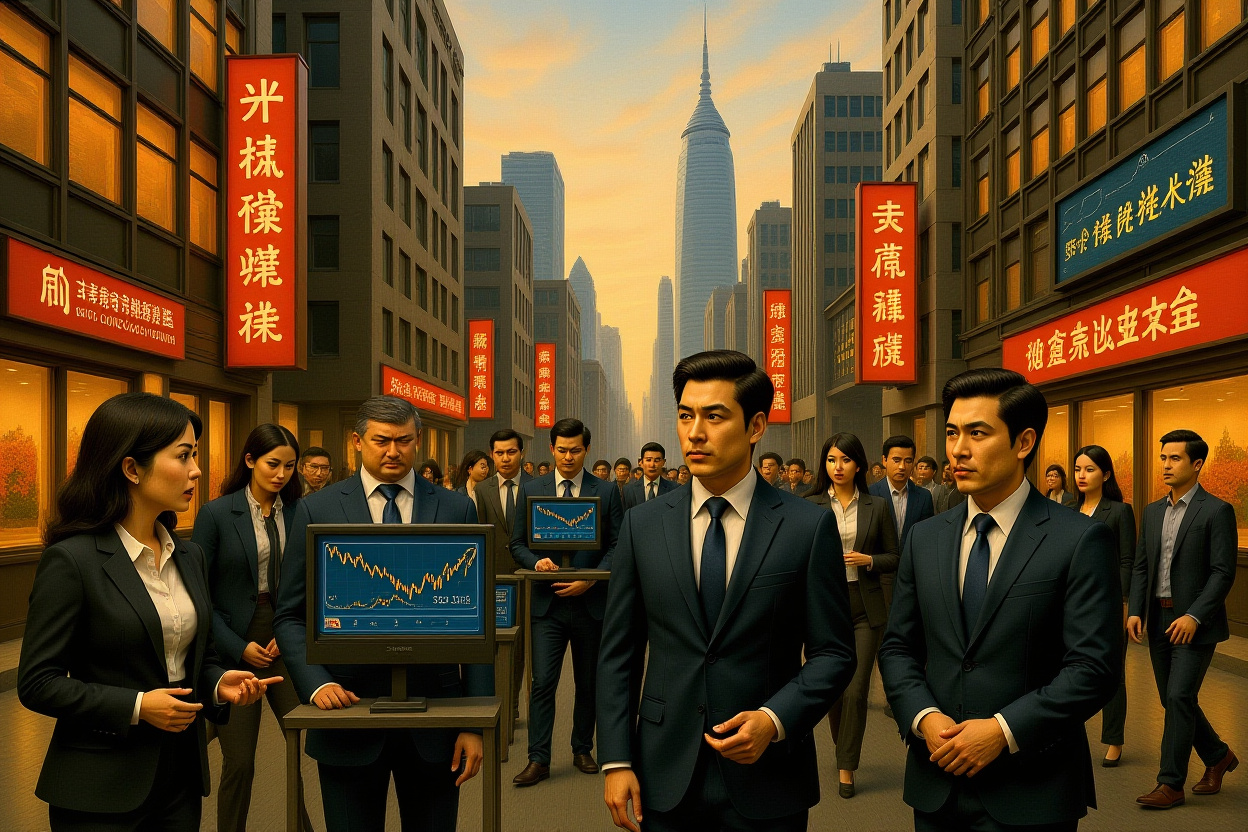Executive Summary
Key developments in the global automotive industry transformation:
– German automotive industry announces over 110,000 layoffs across major manufacturers and suppliers
– China’s electric vehicle sales surge to 12.87 million units in 2024, capturing 65% market share
– Traditional automakers face existential crisis as EV technology disruption accelerates
– Supply chain advantages shifting decisively to Chinese manufacturers
– Global automotive employment patterns undergoing fundamental restructuring
European Automotive Crisis Reaches Critical Mass
The once-dominant German automotive industry is facing its most severe challenge in decades as major manufacturers and suppliers announce unprecedented workforce reductions. Continental AG (大陆集团), Bosch (博世), and Volkswagen Group (大众集团) are among the companies implementing drastic cost-cutting measures that collectively eliminate over 110,000 positions across Germany’s industrial sector.
This automotive industry transformation represents a fundamental shift in global manufacturing leadership. German industrial employment has declined by 2.1% year-over-year, with approximately 114,000 jobs disappearing from the sector. The contraction marks the eighth consecutive quarter of declining industrial revenue, highlighting the structural nature of the challenge.
Major German Auto Layoffs
The scale of workforce reduction is staggering across Germany’s automotive ecosystem. Continental AG plans to cut over 10,000 positions while closing five German factories. Bosch Group has announced nearly 15,000 job reductions since last year. ZF Friedrichshafen (采埃孚) intends to eliminate up to 14,000 German positions, while Mercedes-Benz (梅赛德斯-奔驰) plans thousands of job cuts by 2027.
Volkswagen Group’s restructuring stands as the most dramatic, with 48,000 planned job reductions and three German factory closures. ThyssenKrupp (蒂森克虏伯) adds another 11,000 steel sector job losses to the devastating total. This automotive industry transformation is dismantling Germany’s traditional manufacturing advantage.
Technological Disruption Reshapes Global Auto Landscape
The German automotive crisis stems from slower adaptation to electric vehicle technology compared to Chinese competitors. While German manufacturers maintained their “internal combustion engine supremacy” mindset, Chinese companies aggressively developed EV capabilities. The result is a dramatic shift in competitive positioning that threatens Europe’s industrial foundation.
This automotive industry transformation reflects broader technological displacement patterns. German companies dominated through mechanical engineering excellence but underestimated the speed of electrification. Chinese manufacturers capitalized on government support, manufacturing scale, and battery technology advances to capture leadership in the evolving market.
Battery Technology Investments Falter
International companies have struggled to compete in critical EV components. American transmission specialist BorgWarner announced approximately 500 layoffs at its German battery technology center, reducing staff by 40% in research and 45% in manufacturing. The company acquired German battery maker Akasol for over €700 million in 2021 but failed to achieve technological breakthroughs.
Similarly, Ford announced 1,000 job cuts at its Cologne electric vehicle factory and plans 4,000 European layoffs by 2027. The Cologne facility recently completed its electric transformation but faces insufficient demand and high costs. Ford’s electric division reported $1.3 billion in second-quarter losses, demonstrating the challenges traditional manufacturers face in this automotive industry transformation.
China’s Electric Vehicle Dominance Accelerates
Chinese manufacturers have seized technological leadership through massive research investment and manufacturing scale. BYD (比亚迪) has demonstrated remarkable innovation with its “megawatt fast charging” technology enabling 400 kilometers of range with just 5 minutes of charging. Geely’s (吉利) Thunderbolt hybrid 2.0 technology achieves nearly 48% thermal efficiency with just over 2 liters of fuel consumption during battery charging.
This automotive industry transformation has propelled Chinese brands to unprecedented market share. In 2024, Chinese brand passenger vehicle sales approached 18 million units, capturing over 65% market share. New energy vehicle sales reached 12.87 million units, representing 35.5% year-over-year growth and marking ten consecutive years of global leadership.
August 2025 Performance Data
The growth momentum continues through 2025. August wholesale new energy passenger vehicle sales reached 1.3 million units, increasing 24% year-over-year and 10% month-over-month. January-August cumulative wholesale volume reached 8.93 million vehicles, growing 34% compared to 2024. This sustained expansion demonstrates the powerful momentum behind China’s automotive industry transformation.
BYD exemplifies the technological advancement driving this shift. The company employs over 120,000 research personnel, files dozens of patent applications daily, and receives 20+ patent grants each day. This innovation pace contrasts sharply with traditional manufacturers’ more gradual development cycles.
Structural Advantages Reshape Global Supply Chains
China’s automotive ascendancy reflects broader supply chain advantages rather than individual company success. The entire ecosystem of component manufacturers, battery producers, and technology suppliers has achieved quality improvements while maintaining cost advantages. Chinese automakers consequently reduced reliance on expensive German components, undermining traditional suppliers’ business models.
This automotive industry transformation demonstrates how manufacturing ecosystems evolve. German companies dominated through integrated supply chains and engineering excellence. Chinese manufacturers leveraged policy support, workforce development, and massive infrastructure investment to create competing ecosystems with superior cost structures and faster innovation cycles.
Policy Support and Investment
China’s automotive success stems from coordinated policy, investment, and technological development. Government initiatives created favorable conditions while companies invested heavily in research and development. The convergence of human resources, capital investment, and supportive regulations created powerful momentum in this automotive industry transformation.
The results extend beyond domestic market dominance. Chinese manufacturers are increasingly competitive in international markets, challenging established players globally. This expansion represents the next phase of the automotive industry transformation as Chinese companies leverage scale advantages in broader markets.
Strategic Implications for Global Automakers
The German automotive crisis offers crucial lessons for industry participants worldwide. Traditional strengths in mechanical engineering provide diminishing advantages as software and battery technology become differentiating factors. Companies must accelerate digital transformation and develop new capabilities to remain competitive.
This automotive industry transformation requires fundamental strategic reassessment. Manufacturers cannot cost-cut their way to competitiveness but must develop compelling electric offerings. Partnerships, acquisitions, and internal development must proceed simultaneously to address capability gaps quickly.
Employment Pattern Shifts
The workforce implications extend beyond immediate layoffs. Traditional mechanical engineering roles are declining while software, battery technology, and digital interface positions grow. Companies must manage this transition while maintaining operational capabilities during the transformation period.
Germany’s experience demonstrates how rapidly employment patterns can shift during technological transitions. The loss of over 110,000 positions represents not just individual hardship but broader economic restructuring. Policymakers and companies must collaborate on retraining and transition programs to address these challenges.
Future Outlook and Strategic Recommendations
The automotive industry transformation will continue accelerating as technology improves and consumer preferences evolve. Companies that embrace change and develop distinctive capabilities can thrive despite the disruptive environment. Those clinging to traditional approaches face continued pressure and potential obsolescence.
Strategic flexibility becomes increasingly important in this dynamic environment. Manufacturers must monitor technological developments, regulatory changes, and consumer preferences to adjust strategies rapidly. Partnerships across traditional competitive boundaries may become necessary to access capabilities and share development costs.
Investors and industry participants should focus on companies demonstrating adaptive capabilities and technological advancement. The transition period creates both significant risks and substantial opportunities for those positioned correctly. The companies that successfully navigate this automotive industry transformation will define the next era of mobility.
Monitor regulatory developments, technological breakthroughs, and market share shifts closely as indicators of future competitive positioning. The pace of change requires continuous assessment and strategic adjustment to capitalize on emerging opportunities in this transforming industry.




